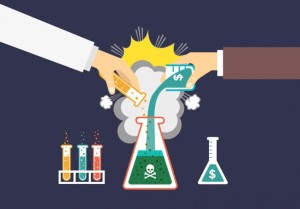
Of the world’s 500 biggest corporations, just 50 of them are generating 75% of the greenhouse gases from corporate sources. According to a 2013 article in the Sustainable Business Journal, “At least 17 of the worst 50 are U.S. companies, many of them in the oil industry: Exxon-Mobil, Chevron, Conoco-Phillips, Apache, Devon Energy and Occidental Petroleum. Other offenders include Carnival, Air Products & Chemicals, Dow Chemical, DuPont, Praxair, AT&T, American Electric Power, Duke Energy, and Exelon.” Some companies like Amazon and Apple declined reporting at all, while others gave only selective information to downplay their carbon footprint. For example, in the financial sector, just 6% disclosed emissions associated with their investments, which make up the majority of their emissions. Bank of America is a good example – it touts its environmental progress while continuing to invest in coal – 50 of the World’s 500 Biggest Companies Undermine Progress on Climate Change.
E & E News published a report in 2014 that quantified economically the societal costs of climate disruption, for anything from “sea-level rise, to extreme heat, and crop losses, that will cost the country several billion dollars annually in the decades ahead”. Of concern is who pays these costs? Costs from flooding, storm damage, wild fires, disease, and drought typically fall on the shoulders of emergency agencies, insurance companies, governments (taxpayers), or simply individuals. Such losses resulting from corporate actions are “externalized” off the company books into the public sphere, by way of denying cause and consequence – ‘Risky Business’ report puts climate costs at many billions of dollars annually.

But now in a 2017 study published by the Climatic Change Journal, the authors report that “Using a simple, well-established climate model, our study for the first time quantifies the amount of sea level rise and increase in global surface temperatures that can be traced to the emissions from the 90 largest carbon producing companies. We have the data needed to link the emissions traced to products sold by a fossil fuel company to a specific share of changes in temperature and sea level rise”. This is a sea change (pardon the pun). Exact costs of given climate disasters can now be pinned on the balance sheets of specific corporations! For example, they report that “More than 6% of the rise in global sea level resulted from emissions traced to ExxonMobil, Chevron and BP, the three largest contributors”. This data can be confidently used by governments to assess corporations for damages, or by individuals or communities to sue corporations for damages. In fact, “Lawsuits filed in July by three coastal California communities against ExxonMobil, Chevron, BP and other large fossil fuel companies argue that the companies, not taxpayers and residents, should bear the cost of damages from rising seas”. Read more at – Big Oil must pay for climate change. Now we can calculate how much.

The organizing cohesiveness of BOLD Nebraska over the years to forge common ground between disparate socio-political interests fighting Keystone XL has been instructive and inspirational. While adjoining states, and U.S. officials alike, have had mixed success resisting the oilagarchy, the people of Nebraska have single handedly stopped TransCanada on multiple fronts – direct action, the courts, the Nebraska Public Service Commission, and creative actions like solar installations along the route of the pipeline. This kind of success can be achieved only by presenting a united front, united only due to mutual respect. The BOLD Nebraska folks, under Jane Kleeb’s guidance, listened to the concerns of conservative farmers and ranchers, school districts, water districts, and tradesmen to build an awareness of the pipeline’s likely impact on their livelihood. The learning curve has been methodical and steady, and has paid off when you read comments like this: “I think if not for Bold, the pipeline would be in today”, says Art Tanderup. Tanderup found that his 160 acre farm, that has been in his wife’s family for 101 years, is in Keystone’s way. “[Jane Kleeb] was the glue that kept us landowners together, and kept the organizing that happened in the state going.” Kleeb related this tale. “About two or three years into the fight, one of the farmers came up to me and asked if I had ever heard of the documentary ‘An Inconvenient Truth’. I started to laugh — I told him that indeed I had, but it’d been a while. And he was like, ‘Well, my daughter got me a Netflix subscription for Christmas, and I’ve been watching all of these documentaries on climate change, and man, we really should have been listening to Al Gore.'”
An article in Popular Science provides insight into the issues, the stakes, and the success of BOLD Nebraska. “Perhaps if TransCanada hadn’t first proposed to put the pipeline not only through a cherished region, but one that rests atop the state’s most precious resource, they would not have encountered such fierce resistance. But they did. And so from the beginning, as it were, the balances were not correct. Nebraskans really, really love their aquifer. Jane Kleeb noted,’There’s books, there’s songs, there’s poetry about the Ogallala Aquifer. We don’t have a ton of corporate agriculture in our state. It’s still family farms and ranches of people who homesteaded in the 1800s, still being run by those same families. Nebraska is kind of unique in that sense.

“‘Everything we do here is out of that aquifer’ says Tanderup, who grows mostly corn, soy, rye, and cover crops on his farm. ‘We drink it, the livestock drink it, we irrigate with it, and we water our gardens with it. It’s our water.’ John Hansen, President of Nebraska’s Farmers Union, believes that the Sandhills make for a risky shortcut. ‘Why would you run a pipeline in an area where, if it leaks, it goes right into the water supply?’
“Jim Carlson, who lives in Central Nebraska said ‘They came, knocked on my door, and offered me a pretty substantial amount of money’. That’s when he decided he should find out more about what was happening in his backyard. He learned that the oil will come from the tar sand fields of Alberta, Canada – a bitumin that isn’t liquid, but closer to the consistency of molasses. John Stansbury, an Associate Professor of Environmental Water Resources Engineering at the University of Nebraska said ‘a small leak from an underground rupture in the Sandhills could pollute almost 5 billion gallons of groundwater, if it went undetected. It’s important to note that when pipelines leak, the problem isn’t usually caught by high-tech leak detection systems. There are two problems with this. The first is that the bitumen sticks to everything — vegetation, rocks, riverbanks — and it’s not easily washed away. The second is that while conventional crude oil floats, bitumen sinks. In the end, knowing that, Carlson turned down a little more than $300,000 rather than allowing Keystone XL to come through his land.
“In August, Bold Nebraska (in coordination with 350.org, Indigenous Environmental Network, and a coalition of other groups) launched a $50,000 dollar crowdfunding effort to build solar installations inside the proposed pipeline route. Said Tanderup ‘My wife and I try to burn biodiesel, we try and burn ethanol, but we need to do more. We invested in a solar system for our farm’. The 91% of the farm’s kilowatt needs it generated last year wasn’t enough to satisfy them. ‘So, we bought an electric car, and we charge it off of the solar panels.’ Now that his eyes are open, Jim Carlson sees the signs of a warming climate all around him. Rising global temperatures make for an earlier spring. ‘We plant corn three weeks earlier than we used to’, he says.” Read more at – This land is (still) their land. Meet the Nebraskan farmers fighting Keystone XL.

Stretched along the Gulf Coast of Texas and Louisiana are some 840 petrochemical plants and refineries, as well as above-and-below ground oil storage tanks, and gas and oil export terminals. In addition, a large number of the more than 170 Texas Superfund sites are concentrated along the coast, 15 of which are in Houston alone. The floodwaters that covered the entire region have created a public health catastrophe that will persist long after the waters recede. Contributing factors are fecal coliform from swamped sewage treatment plants, molds growing in saturated structures, failure of some municipal water supply systems, inundated oil tank farms, leaking chemical plants and refineries, noxious plumes from fires, and the flooded Superfund sites – Harvey Aftermath: A Public Health Crisis in the Making.

There are quite a number of media stories about these various environmental disasters, but one of the more revealing views comes from the industry itself. A commercial group called Independent Chemical Information Service is the world’s largest petrochemical market information provider of pricing information, news, analysis and consulting to buyers, sellers and analysts. They examine in real time the status of supply and demand within 180 commodity markets, and their website has an interactive map to search for information on given products or companies. This map is very busy at the moment, with status reports on every business affected by Hurricane Harvey – Hurricane Harvey impact on the petrochemical markets (interactive map). You can view the entire Gulf Coast, zoom to a regional level, or to a city, or even down to neighborhood scale. Hover over the icon for a company, and see it’s status from a list including: shut down, reduced, restarting, operating, etc., and some disturbing categories such as “upset”, “closed”, and “force majeure”. “Force majeure” is a legal term, referring to a company’s inability to produce a product or service following a storm or other unanticipated event.

While floodwaters and storm winds may have affected the region as a whole, Harvey dumped most heavily on Houston proper. And in Houston, the worst effects are being felt by what are called “fence line” neighborhoods, or environmental justice (EJ) neighborhoods. The Union of Concerned Scientists reported that more than a million pounds of emissions from the oil refineries and chemical plants that border EJ communities have been released into the Houston air. Both common sense and real estate appraisal tell us that land nearby to polluting industries is of poor marketability, so it’s the poor who end up living there. In Houston, the toxic impacts are worse than anywhere else. Houston is the only major city in North America without land use zoning. While other U.S. cities might allow housing to be located somewhat near to industrial sites, in Houston, residential use is allowed immediately across the fence or street from industrial uses – fence line neighborhoods. These neighborhoods are predominantly low-income and ethnic minority areas. It’s no surprise that both polluting industries and EJ neighborhoods are clustered in east Houston. You may want to sign this petition to Congress – Harvey relief MUST address the needs of fenceline communities.
The UCS has paired up with one of the most active EJ groups in Houston – the Texas Environmental Justice Advocacy Services (TEJAS) – TEJAS. Other groups such as the Houston Hip Hop Caucus are addressing the Harvey issues, but TEJAS has been central to EJ organizing for decades, during everyday living conditions and in crisis situations. TEJAS is notifying neighbors about toxic exposure safeguards, giving media interviews, and has filed a court motion to stop the EPA from delaying the Chemical Disaster Rule. Most notably, in response to the explosion and fire at the Arkema liquid organic peroxides factory in Crosby TX, TEJAS is urging nearby residents to evacuate, and pushing for full disclosure of the chemicals used in the facility. To donate to TEJAS, click this link – Donate to the TEJAS Harvey Fund, and be reassured it will go to disaster relief on the ground, not into the bureaucracy of a national agency.

On 31 August 2017, flooding interrupted electric supply to the Arkema peroxides plant. With no back-up power to keep storage tanks of chemicals refrigerated, rising temperatures triggered two spontaneous explosions. Fifteen police officers were taken to a hospital for inhaling fumes, while a 1.5-mile evacuation zone was imposed. Rather than allow the remaining tanks to reach explosive temperatures, on 2-3 September, the company staged “controlled ignition” of six more tanks (set them on fire), to “neutralize” the chemicals as the company described it – Evacuation zone around Arkema’s Texas plant lifted after controlled ignitions. TEJAS and UCS and others had demanded full disclosure of what was in the tanks, and what compounds would then be in the black smoke that neighbors would be breathing, but Arkema refused – (video) Smoke from chemical plant fires caused by Houston flood raises concerns, and As Arkema Plant Burns, Six Things We Know About Petrochemical Risks in the Wake of Harvey.
This report is just the tip of the iceburg. The UCS recommended these additional resources:
Some other sites for further reading are:

Bill McKibben has written an article describing not just the advisability of, but the financial feasibility of supplanting fossil fuels with solar and wind electricity. He points out that our industrial society is on a trajectory toward 100% renewable energy for multiple reasons. Technological advances in the design and scale of both wind turbines and photovoltaic collectors have brought the per-killowatt price down to out-compete coal and nuclear electricity. Heavy investment in electric and hybrid-electric autos has stimulated a rapid growth rate leading to the serendipitous side benefit of a huge rolling storage battery, which in turn offsets the earlier problem of renewables intermittency. Transmission network power pools are upgrading the electric grid to better convey electricity from remote wind farms to urban centers. Rooftop leasing programs for solar collectors has made financing solar within the reach of many more homeowners. Society is passing the tipping point where each of these advances is synergistically combining to make it all cheaper and within reach. As one California utility executive put it: “The technology has been resolved. How fast do you want to get to 100 percent? That can be done today” – The Climate Movement’s New Battle Cry – 100% Renewables.
However, the political (read self-interested, plutocratic, monopolist) battle still goes on, trying to prevent or delay the inevitable. The Koch brothers, the American Legislative Exchange Council, the Americans for Prosperity, the Edison Electric Institute, and others have their surrogates installed in many state legislatures and the three branches of the Federal government, to subsidize and give unfair advantage to centralized big coal and nukes. The Guardian UK recently published a report that Global fossil fuel subsidies are a staggering $5 trillion per year. And Sustainable Business reported that 50 of the World’s 500 Biggest Companies Undermine Progress on Climate Change. But grass roots groups are countering much of that market manipulation by working with progressive Congress people, governors, state legislators, and mayors. The Sierra Club is finding dramatic success with its #ReadyFor100 campaign, which lobbies cities to commit to 100 percent renewable. Various states such as California and New York have set target dates to achieve 100 percent renewable energy. Sen. Bernie Sanders and Sen. Jeff Merkley proposed in April the first federal 100 percent bill – setting the gauntlet for 2018 and 2020.
Ultimately, the economics of renewables will bypass artificially propped-up fossil fuels. The economic strength of renewable electricity can be gaged by employment statistics. Already, more U.S. workers are employed in the solar industry than in coal fields. Bruce Graham, who runs the Cloud County, Kansas wind technician program, said “wind energy program graduates can make $20 to $25 per hour, and supervisors well above $25 per hour”. The wind industry is growing so fast that training schools can’t keep up with the demand – Wind farm growth saps technicians supply. An article in Eco Watch pointed out that six months of regulatory rollback by Trump has done almost nothing to create jobs on oil fields. Technology and economics, not environmental protections, are driving the loss of oil industry jobs. There is very little that this president—or any president—can do about it. The UK, France and Norway have all passed laws banning the sale of gas-powered cars by 2040, which will reduce demand for gasoline, leading to more oversupply of oil and a further downturn in prices. Conversely, Karl Cates, from the Institute for Energy Economics and Financial Analysis said “Low prices for solar and wind are good for employment in the clean-energy sector because they drive development. It’s growing because it’s cheaper. Growth, of course, means more jobs” – Only Renewables Can Provide the Jobs and Revenue Trump Promised From Oil. On a final note – Wind Power Costs Could See Another 50% Reduction by 2030.

It appears that during this Trump era, the EPA is under unprecedented assault, with Scott Pruitt bending or neutering its regulations to favor corporate interests. But this has always been the goal of the laissez-faire deregulation crowd. The main difference now is that Trump has engaged in a high spectacle, full-frontal attack, whereas previous administrations maintained a pretext of scientific objectivity and regulatory balance. This was necessary when there were still checks and balance between the three branches of government – but no more. It’s no-holds-barred with our Federal government in lock down by Neo-cons, Tea Partyers, and the likes of Monsanto and Koch and JPMorgan Chase.
Nowadays, the main impediments to power and profit that corporations want removed from EPA jurisdiction have to do with fossil fuel policies – extraction, pipelines, export terminals, waste, and the costs associated with those. Before climate disruption was acknowledged, or before genetic engineering existed, in the 1970’s and 80’s the EPA focus was more on personal and environmental toxins – pesticides, food contaminants, air and water pollution, acid rain, CFCs and the ozone hole, etc. Either way, “environmental responsibility” was never part of the corporate lexicon, but a “burden” preventing maximization of profits.
Through Congressional bills and EPA regulations, many of the 20th Century environmental problems were resolved, or at least diminished. This seemed true also of toxic agricultural chemicals or food additives, which were subjected to a host of testing and certification. However, the Bioscience Resource Project recently released an exposé titled “The Poison Papers”, that illustrates EPA collusion with the chemical industry in the 1970’s, that allowed pseudoscience or even fraudulent testing to certify dangerous chemicals as being safe.
The Poison Papers represent a vast trove of rediscovered chemical industry and regulatory agency documents and correspondence stretching back to the 1920s. One case has to do with animal testing by the Industrial Bio-Test Laboratories (IBT), which conducted an estimated 35 to 40 percent of all the toxicology tests performed in the United States. When IBT fraud and misconduct was discovered in the 1970’s, the EPA could have ordered retests, and withdrawn its approval from every IBT-tested chemical. Instead, senior EPA administrators held a secret 1978 meeting to cover up the fraud, along with Canada’s Health Protection Branch and executives of the chemical industry. Dr. Jonathan Latham, Director of the Bioscience Resource Project, said the transcript of the meeting “exemplifies as well as any other single document among The Poison Papers, the history of everyday regulatory failures and agency complicity that is the unknown story of the EPA and its enduring collusion with the chemical industry, and whose result is a systemic failure to protect the American public from chemical hazards”.
At this particular meeting which was held at the Arlington VA Howard Johnson Inn, the EPA’s chief representative, Fred Arnold, assured IBT that “no chemicals would be removed from the market, even though the studies supposedly showing their safety had been proven fraudulent”. Dr. Latham notes “As the Howard Johnson transcript reveals, a majority of the IBT studies were never intended to be redone, and still underlie the U.S. chemical regulatory system”. Learn more at – The Poison Papers: Thousands of Pages Discovered, Detail the Secret EPA Collusion With the Chemical Industry, and Bioscience Resource Project.











Recent Comments